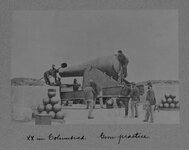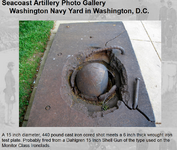misterphelps
Newbie
I’m pretty sure this is a cannonball, but I don’t know if it’s a shell or solid shot.
It’s 15 inches in diameter and about 47 inches circumference. It has one hole about 3/4 diameter and 1 inch or so deep. It’s appears to have a seam running around the circumference although it’s very faint and only visible when wet. It’s completely round without any flat spots.
Is there any way to determine if it’s solid / shell just by looking at it? I know it could be determined by weighing, but it’s extremely heavy so I don’t even know how I could manage to do that. It’s hard enough to move, let alone lift.
If it turns out to be a shell, who can I contact to disarm it? Any idea what it might be worth? I can’t find any other examples online. Thanks in advance for any info.


It’s 15 inches in diameter and about 47 inches circumference. It has one hole about 3/4 diameter and 1 inch or so deep. It’s appears to have a seam running around the circumference although it’s very faint and only visible when wet. It’s completely round without any flat spots.
Is there any way to determine if it’s solid / shell just by looking at it? I know it could be determined by weighing, but it’s extremely heavy so I don’t even know how I could manage to do that. It’s hard enough to move, let alone lift.
If it turns out to be a shell, who can I contact to disarm it? Any idea what it might be worth? I can’t find any other examples online. Thanks in advance for any info.








